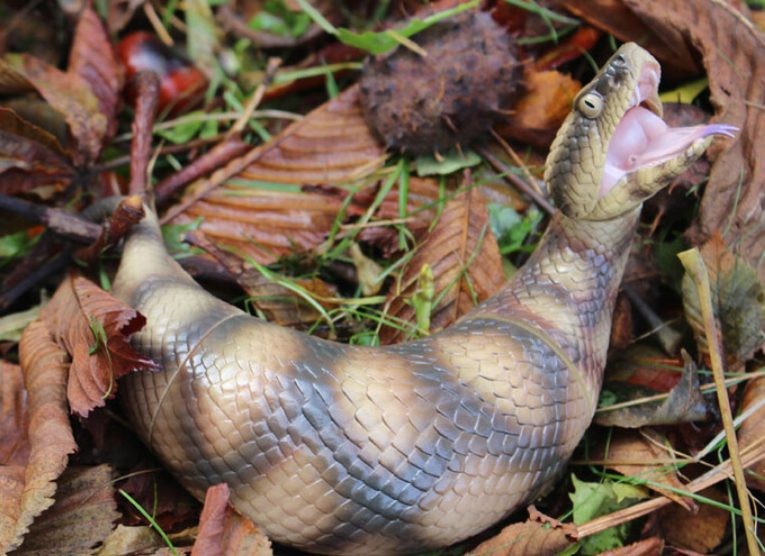
Although not quite as remarkable as other elusive animals found in Japanese folklore, the Tsuchinoko is a well-known Japanese cryptid. It is a type of snake.
According to the legend, the Tsuchinoko inhabits the deep and remote mountains and forests of Shikoku, Honshu, and Kyushu islands and some parts of the Korean peninsula.
These creatures are somewhat similar in appearance to a small but very bulky snake. With its most prominent characteristic being their central girth much wider than the head or tail.
The Tsuchinoko looks almost like a short snake in the beginning of the process of digesting quite a big meal for its size.
The Tsuchinoko is usually reported to be around 1 to 3 feet in length commonly covered with a rust or mottled black coloration. In most cases, the belly is reportedly bright orange. They have a scaly skin?
They are thought to be venomous, with a venom similar to that of viper snakes and fangs to inject it.

Some reports claim that these legendary “venomous snakes” can jump up to 3 feet (1 m) in distance. Now think of this what could be more terrifying than a venomous snake that can jump at you.
Legends claim that the Tsuchinoko can chirp or squeak and may even be able to speak, although they are notorious liars. It’s also said these creatures apparently have a taste for alcohol.
As the legend goes the tsuchinoko can on occasion swallow its own tail being able to roll like a wheel.
That’s a similar behavior to that of the Greek Ouroboros or the hoop snake, the legendary creature of the US, Canada, and Australia.

The name Tsuchinoko which is mostly used in Western Japan, including Kansai and Shikoku, translates to “hammer’s spawn”, “child of the hammer”, “child of gravel”, “child of the earth” or “mallet child” depending on the source.
But these mythical snake-like beings are also known by many other regional names such as bachi-hebi or nozuchi in Northeastern Japan or tsuchi-hebi in Osaka, and many others.
The earliest records of the Tsuchinoko date back to the 7th century, but reports of sightings in recent years have led to its promotion into a full-blown cryptid.
The discovery of a meaningful Tsuchinoko snake skeleton in Yoshii in the year 2000, cemented the tsuchinoko presence in the Japanese pop culture.
At the time the Okayama Prefecture offered a 20 million yen (about 205,000 dollars) reward to hunt the elusive creature.
But like many other cryptids, the Tsuchinoko sightings may be just a misidentification of other animals found in the wild.
Such animals may include the venomous yamakagashi (Rhabdophis tigrinus), or the deadly mamushi (Gloydius blomhoffi) a venomous pit viper found in China, Japan, and Korea which is known to have caused human fatalities.
When we think of Japan we usually remember it’s bustling cities with their skyscrapers and bright neon lights, filled with cars and people, and of course bullet trains.
In short a modern and very industrialized country

But Japan is also a very mountainous country where 90 % percent of the population occupies only about 10 % of the land area.
So there could be countless new species awaiting to be discovered in Japan’s deep and remote mountain forests.
?Who knows maybe the mythical Tsuchinoko of Japan is one of them…